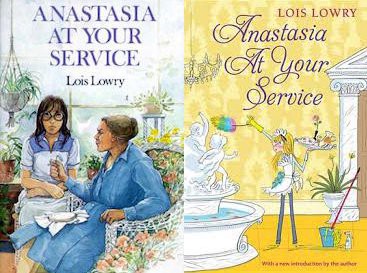What Children’s Literature Teaches Us About Money: Lois Lowry’s ‘Anastasia At Your Service’
Some books are about life, and some are about life lessons.

I used to love the Anastasia books. I can remember so many details: Anastasia only wanting to move if her new home has a tower, Anastasia discovering that she looks better with short hair than with long hair, Anastasia believing that her aunt was killed by a man named Sal Monella. (Not coincidentally, this series made me sufficiently terrified of salmonella.)
I remembered what I thought were the key details in Anastasia At Your Service, too: Anastasia wanting to get a job as an elderly woman’s companion, a la Jo March, and getting hired as a maid instead; Anastasia dropping the “bockle” down the garbage disposal; Anastasia finally having a conversation with her employer and realizing Mrs. Bellingham is a good person under her gruff exterior.
I’d forgotten about Daphne Bellingham, the cigarette-smoking seventh grader who paints her room black, stabs her dolls with paring knives, and asks Anastasia if she wants to sneak vodka into her lemonade. Could you get away with writing a character like Daphne today? For that matter, could you get away with writing a story about a twelve-year-old who has a job?
I’d also forgotten about Anastasia borrowing her mother’s bra and her mother’s pantyhose and stuffing herself a fake bosom so she’d look older than twelve, and then immediately planting that fake bosom into the tray of deviled eggs she’s asked to serve at one of Mrs. Bellingham’s parties. (It’s funny how I remembered the garbage disposal debacle but not the deviled eggs incident.)
Most importantly, I’d forgotten how much of a “lesson book” Anastasia At Your Service is.

All of the books I’ve read thus far can be categorized on a spectrum of “this book is designed entirely to teach young readers a specific lesson” to “this book is about the complexity of life, which defies lesson-making.”
The Hundred Dresses and Charlie and the Chocolate Factory are on the “lesson” end.
From the Mixed-Up Files of Mrs. Basil E. Frankweiler and Harriet the Spy are on the “complexity of life” end.
But Anastasia At Your Service is so far on the “lesson” end that it resets the scale. The book builds to the moment when Anastasia and Daphne, who decide to invite homeless people and “deinstitutionalized psychotics” to Mrs. Bellingham’s hospital fundraiser party because they assume these people will behave badly and ruin the evening, discover, once the party has started, that they cannot identify which guests they invited. They cannot tell homeless from wealthy, they cannot identify which guests are managing mental health issues, and they learn THE LESSON that character matters more than money or health or socioeconomic status.
The fundraiser party is the big LESSON moment, but Anastasia actually learns this lesson three times during the book: first when her father takes her to the apartment building where he grew up so she can see that he lived in a low-income, immigrant neighborhood; second during the climactic fundraiser; and third in the final conversation Anastasia has with Mrs. Bellingham, where she learns that the lesson goes the other way too: character matters more than poverty, but it also matters more than wealth.
It’s pretty easy to explain what Anastasia At Your Service teaches children about money. You could write it as a middle-grade book report:
Anastasia At Your Service is by Lois Lowry. The book is about a girl named Anastasia who wants more money. She learns that who you are matters more than how much money you have. I liked the part where she dropped the bockle down the garbage disposal.
Next week, we’ll go back in the “this book teaches you about the complexities of life” direction and read Katherine Paterson’s Bridge to Terabithia—and you can consider this the start of a Katherine Paterson Double Feature, because the week after that we’re going to re-read Jacob Have I Loved.
Get those library cards ready.
Previously:
- What Children’s Literature Teaches Us About Money: Eleanor Estes’ ‘The Hundred Dresses’
- What Children’s Literature Teaches Us About Money: Patricia MacLachlan’s ‘Sarah, Plain and Tall’
- What Children’s Lit Teaches Us About Money: ‘From the Mixed-Up Files of Mrs. Basil E. Frankweiler’
- What Children’s Literature Teaches Us About Money: Roald Dahl’s ‘Charlie and the Chocolate Factory’
- What Children’s Literature Teaches Us About Money: Ellen Raskin’s ‘The Westing Game’
- What Children’s Literature Teaches Us About Money: Louise Fitzhugh’s ‘Harriet the Spy’
Support The Billfold
The Billfold continues to exist thanks to support from our readers. Help us continue to do our work by making a monthly pledge on Patreon or a one-time-only contribution through PayPal.
Comments